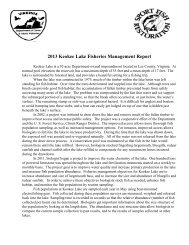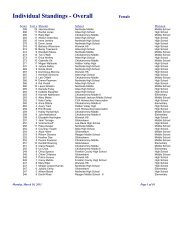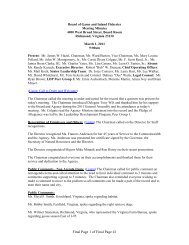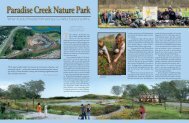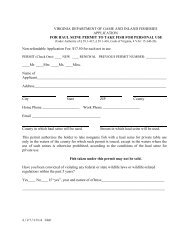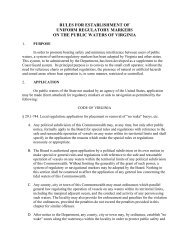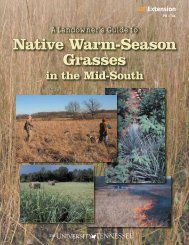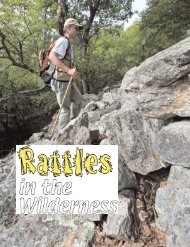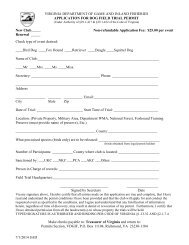ThinningThe fourth major decision is how to thin a pine st<strong>and</strong>.Thinning a pine st<strong>and</strong> in mid-rotation (between 16 <strong>and</strong> 20years post-planting) will increase the quantity <strong>of</strong> future harvestedsawtimber. This is just the expression <strong>of</strong> reducingpine to pine competition. On most first thinning operationsin <strong>Virginia</strong>, trees are thinned by a process termed 50% operatorselect. This usually takes a st<strong>and</strong> down to 200 to 225TPA. At these densities, little canopy opening exists, there<strong>for</strong>every little sunlight hits the <strong>for</strong>est floor, few herbaceousplants grow, few insects are produced <strong>and</strong> usefulness <strong>for</strong>quail, turkey <strong>and</strong> deer is limited.As a general rule, to achieve benefits <strong>for</strong> wildlife undera <strong>for</strong>est canopy, sunlight should strike at least 50% <strong>of</strong> theground at noon. To accomplish this, pine st<strong>and</strong>s must bethinned to 175 or fewer TPA. An ideal compromise is to thinto 150 TPA. Underst<strong>and</strong> that this yields fewer but larger,higher value sawlogs in the future. It also yields morepulpwood at present. Thinning to this level (150 TPA) setsthe stage <strong>for</strong> a potential wildlife bounty.Even if thinning to a lower density is not judged feasibleon an entire plantation, much can be gained <strong>for</strong> wildlife bythinning heavily along field edges, road corridors <strong>and</strong>around st<strong>and</strong> openings. This “edge” habitat <strong>of</strong>ten yieldsthe greatest dividend <strong>for</strong> wildlife, acre <strong>for</strong> acre.By thinning to 150 TPA, much more <strong>of</strong> the <strong>for</strong>est floorreceives sunlight. Half the ingredients are in place, but justlike a chicken seasoning missing a certain spice, somethingmore is required to complete the perfect taste. How youmanage the st<strong>and</strong> after thinning is what really makes orbreaks the deal.▲Loblolly pine plantations reach thinning age <strong>for</strong> the pulpwoodmarkets in <strong>Virginia</strong> between ages 16 <strong>and</strong> 20. From canopy closure(about age 8 – 10) until they are thinned, very little sunlight reachesthe <strong>for</strong>est floor. As a result, there is sparse vegetation <strong>for</strong> most wildlifespecies during this period. A thinning down to 150 – 175 trees per acrepermits adequate sunlight to reach the <strong>for</strong>est floor, allows wildlife food<strong>and</strong> cover to flourish, <strong>and</strong> still retains adequate pines <strong>for</strong> pr<strong>of</strong>itablechip’n’saw or sawlog production. (Photo David C<strong>of</strong>fman, DGIF)(Photo DOF)Ten
The Effect <strong>of</strong> ThinningBACKGROUND - A Hypothetical <strong>Virginia</strong>Case StudyConsider a <strong>Virginia</strong> tree farm located in thePiedmont or Coastal Plain which is average insite quality. After harvest this tract is burned,planted <strong>and</strong> released with herbicide at an overallcost <strong>of</strong> $175 per acre. The site was plantedwith 550 trees per acre <strong>of</strong> second generation,improved loblolly seedlings with a resultantsite index <strong>of</strong> 65 (base age 25). Annual costs are $2per acre <strong>for</strong> property tax <strong>and</strong> $5 per acre <strong>for</strong>management expenses. The st<strong>and</strong> will bethinned at age 20 to three stocking densities <strong>of</strong>approximately 200, 150, <strong>and</strong> 100 residual treesper acre, respectively. This reflects the effects <strong>of</strong>potential trade-<strong>of</strong>fs between financial returnsfrom timber production <strong>and</strong> increased openspace <strong>for</strong> quail <strong>and</strong> other wildlife. The st<strong>and</strong>will be harvested at age 30. Prices <strong>for</strong> pine pulpwood(5"– 8" d.b.h.), chip-n-saw (9"–12" d.b.h.),<strong>and</strong> pine sawtimber (13" d.b.h. <strong>and</strong> up) are $19,$60 <strong>and</strong> $109 per cord, respectively. Prices arefrom Timber Mart-South <strong>for</strong> first quarter 1998,<strong>for</strong> the Piedmont <strong>and</strong> Coastal Plain regions <strong>of</strong><strong>Virginia</strong>. Projected yields are taken fromPCWTHIN, growth <strong>and</strong> yield s<strong>of</strong>tware developedat <strong>Virginia</strong> Tech from a <strong>Virginia</strong> database. Inflation is assumed to be two percent,<strong>and</strong> real price appreciation (price change overinflation) is assumed to be two per-cent. Theresults that can be expected from this case areshown in Table 1.FINANCIAL RETURNSThe results are compared among a no-thinalternative <strong>and</strong> thinning at the three stockingdensities to analyze the effects on returns. Thechoice <strong>of</strong> a 30-year rotation is arbitrary to facilitatethe comparison <strong>of</strong> the alternatives; however,it is close to what might be selected by atypical <strong>Virginia</strong> l<strong>and</strong>owner under similar circumstances.In practice, silvicultural treatmentssuch as thinning <strong>and</strong> fertilization will <strong>of</strong>tenextend or shorten an optimum rotation (i.e.,investment length). The results are examinedbe<strong>for</strong>e-tax, in current terms (with inflation),using internal rate <strong>of</strong> return (IRR), net presentvalue (NPV) at eight percent, <strong>and</strong> l<strong>and</strong> expectationat eight percent. NPV results are onerotation <strong>of</strong> 30-years. L<strong>and</strong> expectation valuesgive results <strong>for</strong> an infinite number <strong>of</strong> rotations.The financial returns <strong>for</strong> the various alternativesare remarkably similar (Table 1). TheIRR <strong>for</strong> the thinned st<strong>and</strong>s is slightly higherthan <strong>for</strong> an unthinned st<strong>and</strong> under theassumed conditions. Similarly, the NPV <strong>for</strong>thinned st<strong>and</strong>s is higher than <strong>for</strong> the unthinnedalternative, but the margin <strong>of</strong> gain issmall. A l<strong>and</strong>owner should include other benefitsto be gained from thinning be<strong>for</strong>e making afinal decision. Because the financial resultsfrom different thinning intensities are similar, al<strong>and</strong>owner may thin more heavily to promotefood <strong>for</strong> quail <strong>and</strong> other wildlife with a minimumsacrifice in financial outcomes.Financial gains from thinning result mainlyfrom promoting leave trees in the st<strong>and</strong> intolarger diameter classes which result in higherprices per unit <strong>for</strong> solid wood products. Theproducts possible from a timber st<strong>and</strong> — pulpwood,chip-n-saw, <strong>and</strong> sawtimber — vary by initialstocking, timing <strong>and</strong> severity <strong>of</strong> thinnings,<strong>and</strong> site index. Financial returns are also affectedby the differentials among the various productswhich are governed by the local market.Properly thinning loblollypines is vital to the longtermvitality <strong>of</strong> the st<strong>and</strong><strong>and</strong> to a l<strong>and</strong>owner ’s economicreturns. St<strong>and</strong>ard“operator-select” thinningin <strong>Virginia</strong> usually takesst<strong>and</strong>s down to 200–225trees per acre. This stopsjust short <strong>of</strong> the level bestsuited <strong>for</strong> wildlife. Thinningto 150–175 TPA maintainseconomic returns <strong>and</strong> provides<strong>for</strong> wildlife.(Photo David C<strong>of</strong>fman,DGIF)▲Table 1. Financial returns <strong>for</strong> loblolly pine on a 30-year rotation under fourthinning regimes, per acre.Thinning regime – IRR, be<strong>for</strong>e-tax NPV @ 6%, L<strong>and</strong> expectationresidual stocking, (%) be<strong>for</strong>e-tax ($) value @ 6%,trees per acre (#) be<strong>for</strong>e-tax ($)No-thin 13.1 688 764200 13.6 735 816150 13.8 766 851100 13.8 760 845Eleven



